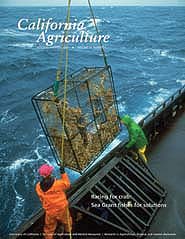All Issues

Racing for crabs:
Sea Grant fishes for solutions
Cover:
Dungeness crab is one of the most valuable Pacific Coast fisheries. While the fishery is considered sustainable, about
80% of the crab is harvested during the first month of the season (December). This race for crab has resulted in glutted markets and dangerous competition. The UC Sea Grant Extension Program surveyed California crab fisherman about management options to spread out the harvest more evenly (see page 186). Shown in the photo are fishermen harvesting snow crab in Alaska, another dangerous crab fishery.*
*Sentence added after press time
October-December 2004
Volume 58, Number 4
Volume 58, Number 4





